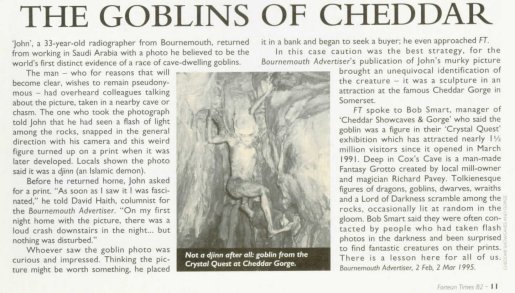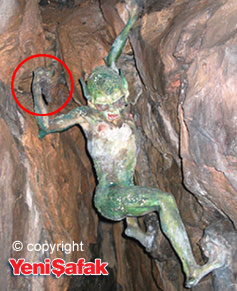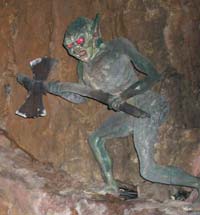November 28, 1998
Q: (L) Okay, I stumbled across some information this week, quite by
accident, about this Horsel business. What it says is: The moongoddess,
or Aphrodite, of the ancient Germans, was called Horsel,
or Ursula... she is the pure Artemis; but, in accordance with her
ancient character, she is likewise the sensual Aphrodite, who haunts
the Venusberg; and this brings us to the story of Tannhauser. The
Horselberg, or mountain of Venus, lies in Thuringia, between
Eisenach and Gotha. High up on its slope yawns a cavern, the
Horselloch, or cave of Venus within which is heard a muffled roar, as
of subterranean water. From this cave, in old times, the frightened
inhabitants of the neighboring valley would hear at night wild moans
and cries issuing, mingled with peals of demon-like laughter. Here it
was believed that Venus held her court; "and there were not a few
who declared that they had seen fair forms of female beauty
beckoning them from the mouth of the chasm. Tannhauser was a
Frankish knight and famous minnesinger, who, traveling at twilight
past the Horselberg, "saw a white glimmering figure of matchless
beauty standing before him and beckoning him to her." Leaving his
horse, he went up to meet her, whom he knew to be none other than
Venus. He descended to her palace in the heart of the mountain,
and there passed seven years in careless revelry. Then, stricken
with remorse and yearning for another glimpse of the pure light of
day, he called in agony upon the Virgin Mother, who took
compassion on him and released him. He sought a village church,
and to priest after priest confessed his sin, without obtaining
absolution, until finally he had recourse to the Pope. But the Holy
Father, horrified at the enormity of his misdoing, declared that guilt
such as his could never be remitted sooner should the staff in his
hand grow green and blossom. "Then Tannhauser, full of despair
and with his soul darkened, went away, and returned to the only
asylum open to him, the Venusberg. But lo! Three days after he had
gone, Pope Urban discovered that his pastoral staff had put forth
buds and had burst into flower. Then he sent messengers after
Tannhauser, and they reached the Horsel vale to hear that a
wayworn man, with haggard brow and bowed head, had just entered
the Horselloch. Since then Tannhauser has not been seen. The
curious thing about this "Horsel" is that it reminded me of the time
that you said I needed to get a better 'handl' on the matter. You later
gave the clue 'chevin,' which means a variation of 'horse,' and there
has been the clue of the arms of Rene D'Anjou in the book The
Tomb of God, which had the vine growing out of the split tree topped
by the rock, through the 'handle' of the grail, then there was the book
The Horse of God. One of the mythical stories repeated about this
Abbe Berengar Sauniere, was that, on his deathbed, he made his
confession and the priest who heard it refused him absolution and
the last rites, and apparently fled from the house horrified. I don't
know if that is true, but it is an interesting story in relation to this
story about Tannhauser, particularly since Sauniere painted the
decoration in his church of Mary Magdalene gazing at a stick with
buds springing out of it, and she was depicted in a grotto, such as
the Horselberg cave. Is this Horselberg something that we are
looking for here?
A: Ever feel as if you are dancing around in circles?
Q: (L) Yes, but one of the unique things about this Horselberg
business is that, the legend is that three 'fiery objects' landed on top
of this mountain. And, if you draw a line from Horselberg, which is a
'big rock,' to the 'big rock' of Luxembourg, it crosses the Rhine
exactly on the big rock of the Lorelei...
A: Tritium.
Q: (L) Well, Lorelei, translated from German, going back to the
Saxon roots, is literally, 'Laura's rock.' I just thought that was VERY
funny. You had said to look for the three, the 'triplicative connecting
profile,' a rock, and you mentioned sirens. Lorelei later evolved into
a story about sirens...
A: Tritium mines.
Q: (L)[To Ark] What is tritium? (A) In physics, it is an isotope of
hydrogen. You have deuterium, and you have tritium, and you make
fusion bombs out of tritium. (L) So, there are tritium mines there? (A)
You cannot mine for tritium because it is a gas...
A: But what does it emanate from?
Q: (A) That's a good question. I don't know. We can find out.
A: Look for clue!
Q: (L) You say I am dancing around in circles...
A: We are saying, as always, pay attention to the words.
Q: (L) Well, this paper says also the following: the divining-rod itself
is but one among a large class of things to which popular belief has
ascribed, along with other talismanic properties, the power of
opening the ground or cleaving rocks, in order to reveal hidden
treasures. Leaving him in peace, then, with his bit of forked hazel, to
seek for cooling springs in some future thirsty season, let us
endeavor to elucidate the origin of this curious superstition. The
detection of subterranean water is by no means the only use to
which the divining-rod has been put. Among the ancient Frisians it
was regularly used for the detection of criminals; and the reputation
of -acques Aymar was won by his discovery of the perpetrator of a
horrible murder at Lyons.
Throughout Europe it has been used from time immemorial by
miners for ascertaining the position of veins of metal; and in the
days when talents were wrapped in napkins and buried in the field,
instead of being exposed to the risks of financial speculation, the
divining-rod was employed by persons covetous of their neighbors'
wealth. If Boulatruelle had lived in the sixteenth century, he would
have taken a forked stick of hazel when he went to search for the
buried treasures of -ean ValOean. It has also been applied to the
cure of disease, and has been kept in households, like a wizard's
charm, to insure general good-fortune and immunity from disaster.
As we follow the conception further into the elf-land of popular
tradition, we come upon a rod which not only points out the situation
of hidden treasure, but even splits open the ground and reveals the
mineral wealth contained therein. In German legend, "a shepherd,
who was driving his flock over the Ilsenstein, having stopped to rest,
leaning on his staff, the mountain suddenly opened, for there
was a springwort in his staff without his knowing it, and the princess
[Ilse] stood before him. She bade him follow her, and when he was
inside the mountain she told him to take as much gold as he
pleased. The shepherd filled all his pockets, and was going away,
when the princess called after him, 'Forget not the best.' So, thinking
she meant that he had not taken enough, he filled his hat also; but
what she meant was his staff with the springwort, which he had laid
against the wall as soon as he stepped in. But now, Oust as he was
going out at the opening, the rock suddenly slammed together and
cut him in two. Here the rod derives its marvelous properties from
the enclosed springwort, but in many cases a leaf or flower is itself
competent to open the hillside.
The little blue flower, forget-me-not, about which so many
sentimental associations have clustered, owes its name to the
legends told of its talismanic virtues. So, here we also have staffs
and flowers and birds and all sorts of things that can 'open the
ground,' something going on underground, 'rock-breaking' plants,
such as 'saxifrage' which became sassafras. It says here: 'the
further we penetrate into this charmed circle of traditions, the more
evident does it appear that the power of cleaving rocks or shattering
hard substances, enters as a primitive element into the conception
of these treasure showing talismans.' Then it talks about the
schamir, by which aid Solomon was said to have built his temple,
and that it is like a 'worm no bigger than a barleycorn' that could split
the hardest substance. The bottom line is, that some kind of power,
rock breaking, ground-penetrating power...
A: Does not gold conduct electricity, heat, etc.?
Q: (L) Yes, and gold is also called a ferrophile metal, or 'iron loving,'
because it binds easily with iron.
A: And iron...
Q: (L) Iron in the blood... iron in the ground...
A: Magnetic...
Q: (L) Exactly. Anyway, somehow, all this connects backward to
something that Solomon used to build his temple, and you told us
previously that the secret that the Templars discovered UNDER the
temple, was something that related anti-gravity and that it was
'buried in Galle.' So, yes, we are going in circles. Can you comment
on my comments?
A: Circles, hmmm...
Q: (L) Yes, they are circles. The next thing we come to is that I
discovered that alfalfa, in fact, a very particular type of alfalfa, does,
indeed, grow in the German highlands. And, in fact, this alfalfa was
brought via a route that you described... as France, Spain, Canary
Islands, and Morocco. I was asking about this story of the purported
travels of Mary Magdalene, and you said that the people were not
important, that the message was. You then said that the 'artifacts
hold the key' and listed this sequence of places. I found a paper on
the subject of alfalfa which described this exact route of the spread
of alfalfa and it's value in farming because it literally replenishes the
ground it is grown in. So, it seems that you were describing the route
of the alfalfa plant. Can you comment on this?
A: Now that you have found this out, perhaps you should research
the properties of this mineral Rich in alfalfa and what it does for the
body of homo sapiens??
Q: (L) That is an interesting thing. Alfalfa was named as the 'father
of foods,' and was grown, primarily for, interestingly, horses! And,
we have chevin and the 'Horse of God.' Anyway, one of the primary
areas where this particular type of alfalfa was grown happens to be
in Baden, right next door to this Horselberg... right off the banks of
the Rhine. There is a valley there. Clover is, of course, a variation of
alfalfa, and 'dale' is a depression in the ground. Could this be right
there next to the location of the Lorelei rock off the Rhine?
A: Closer, and what of the four leaves?
Q: Yes, indeed. I will work on that.
[...]
Q: (L) You said at one point that I should transfer the search to the
United States and quit messing around in Europe. I have pored over
maps for days, I have examined the index in the Atlas, and, aside
from Hot Springs, Arkansas, and Tempe, Arizona, and the Plains of
San Augustin, Socorro, Roswell, Magdalena, etc., nothing has really
caught my eye. None of those places configure in any way that
makes sense to me. Can you help me out here?
A: Horseheads, N.Y.
Q: (L) Does this mean.... Horsehead, New York?
A: Horseheads.
Q: (A) In what way is this to be related?
A: Is a key. Need lots of keys to unlock the house of gables.
Q: (L) Seven. Seven keys. Aaaaah... there's Horsecave, Kentucky...
A: Anywhere near Mammoth Cave?
Q: (L) Yes, I believe so. Help me out here!
A: We are.
Q: (L) I feel like I just got picked up by the 'great Roc' and carried
across the ocean and dropped, 'SPLAT' in the middle of another
continent, without a clue about where to look!
A: We did not say "quit messing around in Europe." Just do not limit
it to that.
Q: (L) Well, I STILL want to know what is at the root of the mystery
of Rennes-le-Chateau, and why all this 'cottage industry' in treasure
hunting is going on there...
A: Treasure hunters lack patience in their quest.
Q: (A) Is there something about these places, properties of certain
minerals located at these sites around the world, is this an important
factor?
A: Partly.
Q: (A) Okay, there are three possibilities. The first possibility is there
are some important places because they are located in a special
geo-magnetic position; second, these places are important because
there are some natural resources there which make possible there
something which is very difficult in other places. The third possibility
is that these places have been used many, many years ago to bury
some technological devices... and these three things can be
related....
A: And all three can be true, in fact.
[...]
Q: (L) Do buried minerals in the ground have something to do with
window areas?
A: Ditto.
Q: (L) Are there large caches of gold buried at different places
around the planet to enhance the 'window' effect?
A: Good possibility.




 Yep. Certainty is something I threw in the bin years ago, along with stating, out loud, what I'm going to do. Why? Once stated, every possible program & General Law Monkey Wrench is then thrown in the way. Vigiliance? That's fine. Declaring "This is what I'm gonna do"? Nope.
Yep. Certainty is something I threw in the bin years ago, along with stating, out loud, what I'm going to do. Why? Once stated, every possible program & General Law Monkey Wrench is then thrown in the way. Vigiliance? That's fine. Declaring "This is what I'm gonna do"? Nope. 



